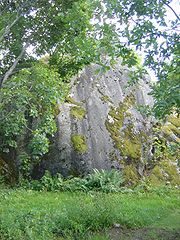
Stenberga Castle
Encyclopedia

Masku
Masku is a municipality of Finland.It is located in the province of Western Finland and is part of the Finland Proper region. The municipality, which is located just north of Turku, has a population of and covers an area of ofwhich...
, Finland
Finland
Finland , officially the Republic of Finland, is a Nordic country situated in the Fennoscandian region of Northern Europe. It is bordered by Sweden in the west, Norway in the north and Russia in the east, while Estonia lies to its south across the Gulf of Finland.Around 5.4 million people reside...
. It was originally built of gray stone, consisting of two towers with outer dimensions of 13 x 13 and 9 x 7 metres, respectively. The castle walls were two metres thick. In a later phase, bricks were also used in the construction. The castle was situated on a steep rock, presumably an island back then, by the sea near the mouth of Hirvijoki River, flowing from Nousiainen
Nousiainen
Nousiainen is a municipality of Finland. The seat of the bishop of Finland was in Nousis in the early 13th century.It is located in the province of Western Finland and is part of the Finland Proper region. The municipality has a population of...
. Due to the post-glacial rebound
Post-glacial rebound
Post-glacial rebound is the rise of land masses that were depressed by the huge weight of ice sheets during the last glacial period, through a process known as isostasy...
, the location is now almost 2 km from the coastline. Very little remains of the castle.
Excavations have not been carried out on the site since the early 20th century, which has given room to dispute the castle's age. Some historians see it as a 14th century construction, while others date it to the late 12th century, when King Canute
Canute I of Sweden
Canute I, Swedish: Knut Eriksson , was king over all of Sweden from 1173 to 1195...
built similar-looking small defensive castles in various parts of Sweden
Sweden
Sweden , officially the Kingdom of Sweden , is a Nordic country on the Scandinavian Peninsula in Northern Europe. Sweden borders with Norway and Finland and is connected to Denmark by a bridge-tunnel across the Öresund....
. According to more or less vague chronicles, Finland seems to have been under special military attention by Danish, Swedish and Russian forces
Finnish-Novgorodian wars
The Finnish–Novgorodian wars were a series of conflicts that took place between Finnic tribes in eastern Fennoscandia called "Yem", and the Republic of Novgorod from the 11th or 12th century to early 13th century. The wars seem to have contributed to the eventual Swedish conquest of Finland in...
in the 1190s, thus giving the possible context for the construction of the castle. Historian Ericus Olai claimed in the late 15th century that bishop Kol of Linköping (d. 1196?) had been the Duke of Finland
Duke of Finland
Duke of Finland was an occasional medieval title granted as a tertiogeniture to the relatives of the King of Sweden between the 13th and 16th centuries. It included a duchy along with the feudal customs, and often meant a veritably independent principality...
(Dux Finlandiae), which however can not be confirmed from other sources. Also noteworthy is the castle's strategic position closing the maritime access to Nousiainen
Nousiainen
Nousiainen is a municipality of Finland. The seat of the bishop of Finland was in Nousis in the early 13th century.It is located in the province of Western Finland and is part of the Finland Proper region. The municipality has a population of...
, which was the earliest presumed see of the Bishop of Finland. The see was moved to Koroinen
Koroinen
Koroinen is a district in the Koroinen ward of the city of Turku, in Finland. It is located to the north of the city centre, across the river Aura from the Turku Student Village....
latest in the mid-13th century.
Whatever the case, the castle itself is not mentioned in historical sources during the time when it was in operation. The Stenberga estate around it is first mentioned in 1398 as the property of the then bailiff of the Turku Castle
Turku Castle
Turku Castle is a monument of Finnish history situated in the city of Turku in Finland. Together with Turku Cathedral, the castle is one of the oldest buildings still in use in Finland. Turku Castle is the largest surviving medieval building in Finland and one of the largest surviving medieval...
. The estate was later donated to a Bridgettine monastery in Naantali
Naantali
Naantali is a city in south-western Finland, known as one of the most important tourist centres of the country. The municipality has a population of , and is located in the region of Finland Proper, west of Turku....
in the 1430s. According to some historians, the abandoned castle was soon thereafter disassembled to get construction material for the monastery, which was only some ten km away. In 1556, the estate, along with other property of the monastery, was confiscated to the state during the Reformation
Protestant Reformation
The Protestant Reformation was a 16th-century split within Western Christianity initiated by Martin Luther, John Calvin and other early Protestants. The efforts of the self-described "reformers", who objected to the doctrines, rituals and ecclesiastical structure of the Roman Catholic Church, led...
.
Today, the site is on private property, and has not been maintained for years. Land-owner's permission is required for a visit. The limb to the hilltop across steep rocks and bushes may be difficult.

